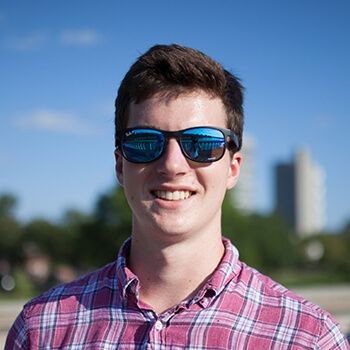Name: Alex Wulff
Concentration: Electrical engineering
Graduation Year: 2021
Hometown: Syracuse, N.Y.
Internship focus: Systems engineering in radar systems and design
Internship location: Lockheed Martin, Syracuse, N.Y.
Describe your internship.
This summer I worked in Lockheed Martin’s rotary and mission systems division in Syracuse, N.Y., doing systems engineering. While there, I worked on two different radar-related projects. The first project I helped support was a ground-based surveillance radar, where I did template design and modelling. Radar “templates” are the patterns of energy that a radar array will emit as it scans the sky. For example, an array might use a special pattern of energy at lower altitudes that helps it reduce interference from obstacles on the ground. A large part of template design is verifying that a given template will meet performance specifications; as part of my work, I utilized various radar performance evaluation tools to ensure that my templates provided adequate coverage of all areas of interest. My work will be deployed on a real radar system. I also worked on an airborne radar project.
What is one of the most valuable lessons you learned from this internship, and why?
Much of defense contracting revolves around organization, procedure, and teamwork. The size and scope of these three elements seemed unnecessary to me at first, but as I became more and more engaged in my work I began to appreciate the power of structure for large projects. The success of a team throughout major endeavors relies as much upon the individual team members as it does upon how the team is set up. By the end of my internship, I realized just how important it is that a team is organized, communicative, and focused. I think this will be especially helpful for my projects throughout SEAS and as I enter the workplace.
What is one of the biggest challenges you faced during this internship, and why? How did you overcome it?
Probably the biggest hurdle I faced was a general lack of knowledge about how radar works, design considerations for radar systems, and how radar performance can be simulated. I first tried to bridge the gaps in my knowledge primarily through online research. This worked to some extent, but I found that I lacked the intuitive understanding of many concepts that separates good engineers from great ones. To remedy this, I used the knowledge of the people around me. I asked the engineers around me the questions that I had been keeping in my head and to my delight, I found that everyone I asked questions to at Lockheed Martin loved teaching radar concepts as much as I enjoyed learning them. I gained a ton of valuable insight this summer solely through conversations, and I hope to continue this at Harvard with faculty and students.
What skills from your courses at SEAS helped you the most during this internship, and why?
The most valuable classes for the work I did this summer were the ones that featured signal processing and control systems. I would’ve been completely lost without a strong understanding of the basics of signals, how they’re acquired, and how they can be processed to yield interesting information. Radar design revolves around increasing the signal to noise ratio of a given radar array, and radar engineers use myriad signal processing techniques to do so. My SEAS classes provided both a technical and intuitive understanding of fundamental concepts in signals and systems that allowed me to contribute to the team.
Why has this internship been a good experience for you?
I had a great time this summer, and I learned many important lessons about both specific radar-related concepts and the workplace in general. Before this internship I considered myself a more hardware-oriented person, but I came away from my internship with a new respect for signals and simulation.
How did you find out about this internship?
I’m from a small town outside Syracuse, and Lockheed Martin has always had a large impact in my community. The Lockheed Martin facility in Syracuse employs over 1,500 people. I participated in many science fairs throughout high school, and at every single one there were multiple judges from Lockheed Martin. Exposure such as this to the talented engineers working at Lockheed Martin made it a top choice in my internship search, with the added benefit of the facility being close to home.
Press Contact
Adam Zewe | 617-496-5878 | azewe@seas.harvard.edu
